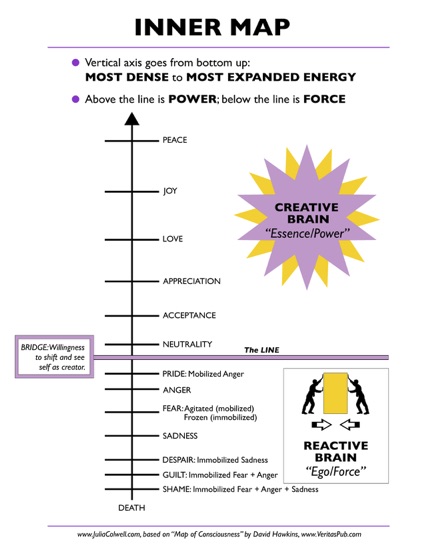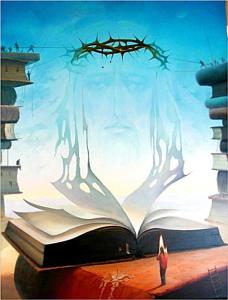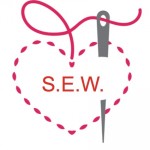Hello Patheos readers!
If you know me, you know how much I appreciate having the right tool for the job. I love the satisfaction of getting the perfect wrench to loosen that darn rusted nut, or having the instructions specify “drill using a 5/16” bit” and having THAT EXACT BIT.
Similarly, I’ve amassed a whole chest of tools and practices for creating more expanded consciousness. These will help you shift out of the stuckness and suffering of Reactive Brain and back into Creative Brain, or they’ll simply support you to feel even more expanded and creative than you already feel.
My plan is to intersperse teaching you about my favorite consciousness power tools with other topics I blog on. Try them out, practice them, gain some mastery in using them. Over time, you’ll discover your own satisfaction—in having the right tool for the job.
POWER TOOL #1: THE INNER MAP
I’ve been developing the Inner Map for the past ten years.* At this point, it’s simply second nature for me know where I am on the Map. Like the temperature gauge on the car dash, the Inner Map gives ongoing feedback on whether all is well, things are easy and cool, or whether something is happening to cause overheating and possible seizing up of the engine.
The Inner Map is such a useful and versatile tool. I want to be sure you get the most out of it, so will introduce different aspects of it over the next few blogs.
Step One:
Download a copy of the map here. Here’s what it looks like:

Get to know your way around it. Knowing your location on the Map will tell you when you are best able to solve problems, cooperate with others, have true connection, and operate in ease and flow. Or, alternatively, when you need to slow down, stop to put some more oil in the system or take time to hang out in the next rest area.
First, orient yourself to the vertical line. Start at the bottom with Shame and look up the line to Guilt, Despair, etc. These are states that start at the most contracted (Shame has very little movement, little more than Death; in fact, when mammals are in Shame they are a deeply frozen response, an anesthetized response that is preparing them for death). As you move up the line, each state has a little more energy, more space, is somewhat more expanded. In fact, Hawkins saw the movement up the line as creating exponentially more energy.
As you start to orient yourself, understand that this isn’t about higher is better. In fact, though the Inner Map you’re looking at is two-dimensional, a much more accurate version of how this works is the model of the Hoberman Sphere. Check this out:
See how this works? When the sphere is most pulled in, that’s Shame. As it begins to open, it has progressively more energy and more space. Like breathing, we move in and out of contraction and expansion all day long.
Now look back at the Map and find the horizontal line (aka, “The Line). That is an important demarcation, one we’ll come back to over and over. It’s the difference between being in Reactive Brain and Creative Brain. Anytime we perceive a threat, we go into Reactive Brain. How do you know you’re in Reactive Brain? You don’t feel good. You might feel adrenalized and focused, but you don’t have a sense of relaxation and ease that are the hallmarks of Creative Brain. As you start to pay attention, you may notice a sense of slight nausea and stiffness. Or, as your own Reactive Brain intensifies, tune into the full-out rapid pulse, muscle contraction, narrow focus, increased blood pressure, and other classic symptoms of the fight/flight/freeze response.
OK, that’s a good start on the Inner Map. Once you’ve downloaded the Inner Map, your homework from today is to pay attention to your state. Watch for when you’re Above the Line (in Creative Brain) or Below the Line (Reactive Brain); you may even be able to tell what more specific state you’re in.
Julie Colwell, PhD is a psychologist in private practice in Boulder, Colorado. She’s the co-founder of the Boulder Center for Conscious Community, a teacher, facilitator, and community leader. She’s teaching an upcoming Essentials Retreat March 17-19. Find her at http://www.juliacolwell.com
*Note that the Inner Map is based on David Hawkins’ brilliant Map of Consciousness, that he introduced in Power vs Force, 1994, Veritas Publishing Co)














